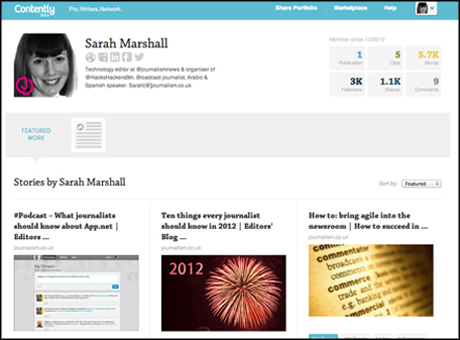
With so many online portfolio tools available it's easier than ever to share your work online. The problem is knowing where to start and how best to market yourself.
Online portfolios allow journalists to show their work to prospective employers, commissioning editors and share it with different audiences, so it is important to pick a site that suits your needs, and make the most of the features on offer.
Here is a run down of just five of the different features online portfolio sites have on offer.
1. Options to make it personal
If you don't have your own website then you might be keen to show off your portfolio using your own domain name.

Writer's Residence allows its users to host a portfolio, blog and pages, such as an 'about me' page, at a web address of their choice. Founder Monica Shaw told Journalism.co.uk that the aim is to make the journalist "look like they have their own website".
"For writers, especially new ones, you're trying as hard as you can to portray yourself as a professional and one of those things is really having a website that is tailored for you and doesn't look like everybody else's," she said.
Clippings.me, another portfolio site, also offers the option of using your own domain, launching this as a pro feature earlier this year.
2. Analytics
Clippings.me offers a range of different tools for journalists. One of the pro features is the ability to find out who is following you and how long they stayed on your page for.

The platform also produces statistics on how your work is being shared. Founder Nicholas Holmes told Journalism.co.uk in an email that "social statistics enable journalists using Clippings.me to immediately see where their work is most shared: which articles have performed the best on Twitter or Facebook, or which publications receive the most shares on average.
"This helps them to quantify their effort and produce articles that are more widely shared and read."
3. Networking opportunities
Muck Rack was founded in 2009 to monitor "what journalists are talking about on Twitter". Since then it has launched a portfolio tool that allows users to connect with other journalists.

Speaking to Journalism.co.uk via email, co-founder Gregory Galant said "the best part about Muck Rack portfolios is that they're an entry into a community of journalists that use Muck Rack – so your work will be seen as people browse our directory, read the Muck Rack Daily [an email] and follow along on social media"
He added that the platform is "designed to get journalists more followers on social media, better career opportunities and a more efficient way to handle sources".
4. Backup tools
What's worse than links that don't work? Pressfolios automatically creates PDF backups of your online articles so that if the link breaks your work is still accessible. Co-founder Marc Samson said "it's critically important for journalists to backup their stories", and so the platform hopes to help them with this task.

"Thousands upon thousands of links head to the deadpool every day, quietly and without notice.
"In the media, sometimes it's because a publication goes under, sometimes links disappear when organisations make changes to their databases (unintentional data loss), and sometimes it's planned database trimming.
"The reasons vary, but the fact remains: links are vulnerable, whereas PDFs are permanent.”
5. Finding your work automatically
Contently, which works with journalists, publishers and brands, has a tool that can locate journalists' online work so that it can be easily uploaded. Shane Snow, chief creative officer at Contently, told Journalism.co.uk via email that its 'story slurper' is "the most useful (and coolest) feature of Contently's journalist portfolios".

The tool "automatically finds all of your clips from the publications you've written for, and also detects when you have written new pieces, so you can add them to your portfolio in a single click," he said. "So, no manual work to slog through."
This list is by no means meant to be exhaustive, and it is worth noting that there may be some overlapping of features available in those platforms mentioned above and others. Please share any other examples of other useful features or platforms for journalists in the comment below.
Free daily newsletter
If you like our news and feature articles, you can sign up to receive our free daily (Mon-Fri) email newsletter (mobile friendly).









